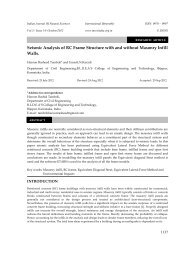Agroecology for Sustainable Food Security - tnsroindia.org.in
Agroecology for Sustainable Food Security - tnsroindia.org.in
Agroecology for Sustainable Food Security - tnsroindia.org.in
Create successful ePaper yourself
Turn your PDF publications into a flip-book with our unique Google optimized e-Paper software.
Indian Journal Of Natural Sciences ISSN: 0976 – 0997<br />
Vol1 / Issue 2 / October 2010 © IJONS<br />
has become the most commonly used agent <strong>for</strong> type 2 diabetes <strong>in</strong> children and teenagers. Amongst common diabetic<br />
drugs, met<strong>for</strong>m<strong>in</strong> is the only widely used oral drug that does not cause weight ga<strong>in</strong>.<br />
Thiazolid<strong>in</strong>ediones<br />
Thiazolid<strong>in</strong>ediones (TZDs), also known as "glitazones," b<strong>in</strong>d to a type of nuclear regulatory prote<strong>in</strong> <strong>in</strong>volved <strong>in</strong><br />
transcription of genes regulat<strong>in</strong>g glucose and fat metabolism. These act on Peroxysome Proliferator Responsive<br />
Elements (PPRE). The PPREs <strong>in</strong>fluence <strong>in</strong>sul<strong>in</strong> sensitive genes, which enhance production of mRNAs of <strong>in</strong>sul<strong>in</strong><br />
dependent enzymes. The f<strong>in</strong>al result is better use of glucose by the cells.<br />
Alpha-glucosidase <strong>in</strong>hibitors<br />
Alpha-glucosidase <strong>in</strong>hibitors are "diabetes pills" but not technically hypoglycemic agents because they do not have a<br />
direct effect on <strong>in</strong>sul<strong>in</strong> secretion or sensitivity. These agents slow the digestion of starch <strong>in</strong> the small <strong>in</strong>test<strong>in</strong>e, so that<br />
glucose from the starch of a meal enters the bloodstream more slowly, and can be matched more effectively by an<br />
impaired <strong>in</strong>sul<strong>in</strong> response or sensitivity.<br />
Peptide analogs<br />
Incret<strong>in</strong> mimetics<br />
Incret<strong>in</strong>s are <strong>in</strong>sul<strong>in</strong> secretagogues. The two ma<strong>in</strong> candidate molecules that fulfill criteria <strong>for</strong> be<strong>in</strong>g an <strong>in</strong>cret<strong>in</strong> are<br />
Glucagon-like peptide-1 (GLP-1) and Gastric <strong>in</strong>hibitory peptide (aka glucose-dependent Insul<strong>in</strong>otropic peptide or<br />
GIP). Both GLP-1 and GIP are rapidly <strong>in</strong>activated by the enzyme dipeptidyl peptidase-4 (DPP-4).GLP agonists b<strong>in</strong>d<br />
to a membrane GLP receptor. As a consequence of this, <strong>in</strong>sul<strong>in</strong> release from the pancreatic beta cells is <strong>in</strong>creased.<br />
DPP-4 (Dipeptidyl peptidase-4) <strong>in</strong>hibitors<br />
Dipeptidyl peptidase-4 (DPP-4) <strong>in</strong>hibitors <strong>in</strong>crease blood concentration of the <strong>in</strong>cret<strong>in</strong> GLP-1 (glucagon-like peptide-<br />
1) by <strong>in</strong>hibit<strong>in</strong>g its degradation by dipeptidyl peptidase-4 (DPP-4).<br />
Amyl<strong>in</strong> analogues<br />
Ramasubramaniaraja and Niranjan<br />
Amyl<strong>in</strong> agonist analogues slow gastric empty<strong>in</strong>g and suppress glucagon. They have all the <strong>in</strong>cret<strong>in</strong>s actions except<br />
stimulation of <strong>in</strong>sul<strong>in</strong> secretion. Praml<strong>in</strong>tide is the only cl<strong>in</strong>ically available amyl<strong>in</strong> analogue. Like <strong>in</strong>sul<strong>in</strong>, it is<br />
adm<strong>in</strong>istered by subcutaneous <strong>in</strong>jection. The most frequent and severe adverse effect of praml<strong>in</strong>tide is nausea, which<br />
occurs mostly at the beg<strong>in</strong>n<strong>in</strong>g of treatment and gradually reduces.<br />
146



